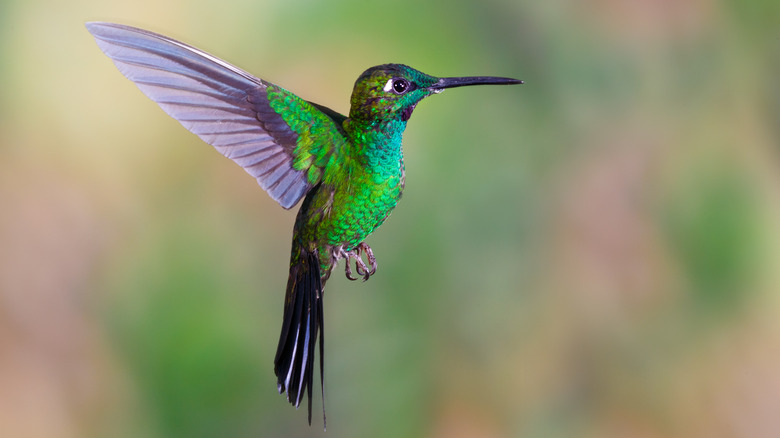Hummingbirds Will Visit Your Yard For This Tall & Spikey Cottage Garden Flower
The only thing more charming than a cottage garden is a cottage garden full of hummingbirds. By choosing plants that not only work with the cottage aesthetic, but also appeal to hummingbirds and other pollinators, you can easily create a vibrant and thriving backyard ecosystem. One of the best flowers for this is the whimsical and quintessentially cottagecore foxglove.
Native to Europe, foxgloves (Digitalis spp) have long been prized for their tall spikes of bell-shaped flowers. Considering their beauty, it's no wonder they have made their way into so many gardens around the world. As many foxgloves are hardy in zones 4 through 9, these plants are able to grow in a wide range of areas. As lovely as foxglove is, though, there are a few things to keep in mind before growing it. Not only are some foxglove species invasive in parts of North America — with common foxglove (Digitalis purpurea) even making the Prohibited Plants List for the city of Eugene, Oregon — foxgloves are also extremely poisonous. While this toxic compound has been invaluable for helping doctors create medicines to treat certain heart conditions, ingesting any part of foxglove can result in severe symptoms or even death. If you have pets or young children, use extreme caution if you're considering growing foxglove.
Growing and caring for foxgloves
If you are able to grow foxgloves safely and have ensured that they are not invasive in your area, then you have a few options for buying your foxgloves. While foxglove seeds are easily available for sale from many seed retailers, you can also purchase live plants if you prefer. Be sure to check whether the plants or seeds you choose are first-year bloomers or require two years to produce flowers, as foxglove is available in annual, biennial, and perennial forms.
Foxgloves grow best in full or partial sun and thrive in well-draining soil with plenty of organic material. As foxglove prefers acidic soil with a pH below 6.0, it's best to measure the pH of your soil and amend it as needed before planting your foxgloves. Don't forget to keep the soil moist and give the foxgloves a balanced slow-release fertilizer to keep them healthy if your soil is deficient in any nutrients. With a little bit of care it isn't difficult to successfully grow foxgloves.
Using foxgloves to attract hummingbirds to your cottage garden
It's easy to incorporate foxgloves into your perfect cottage garden. Their tall, spikey shape and heights of up to 5 feet make them perfect for the back of borders or garden beds. You may need to provide the plants with a few stakes for support but don't worry about creating neatly spaced plantings. Informal layouts with tightly grouped plants and a lack of straight lines are hallmarks of the cottage garden aesthetic.
Other plants to consider adding along with foxgloves in your cottage-style hummingbird garden include salvia (Salvia spp.), bee balm (Monarda spp.), and phlox (Phlox spp.). Not only do hummingbirds absolutely love these flowers that look great in North American cottage gardens, but the companion plants also thrive under similar conditions to foxgloves. While roses are not known for their ability to attract hummingbirds, you may also want to add a few in your garden as they contribute to the cottage garden style, and many varieties grow well under the same conditions as foxgloves.


